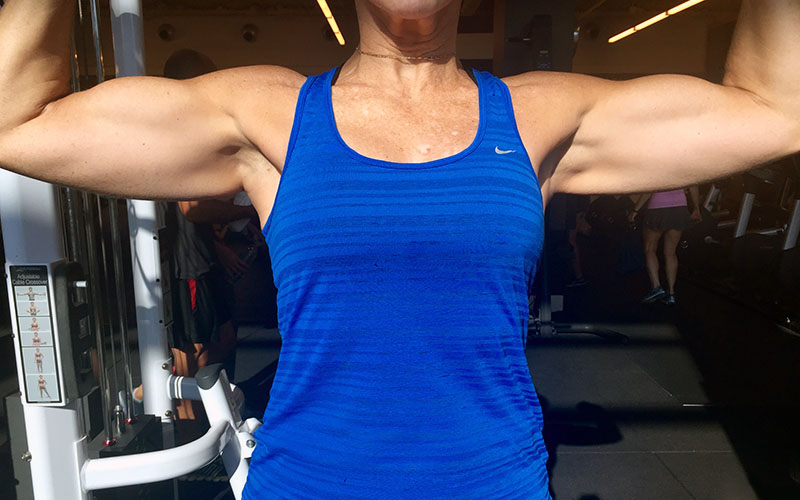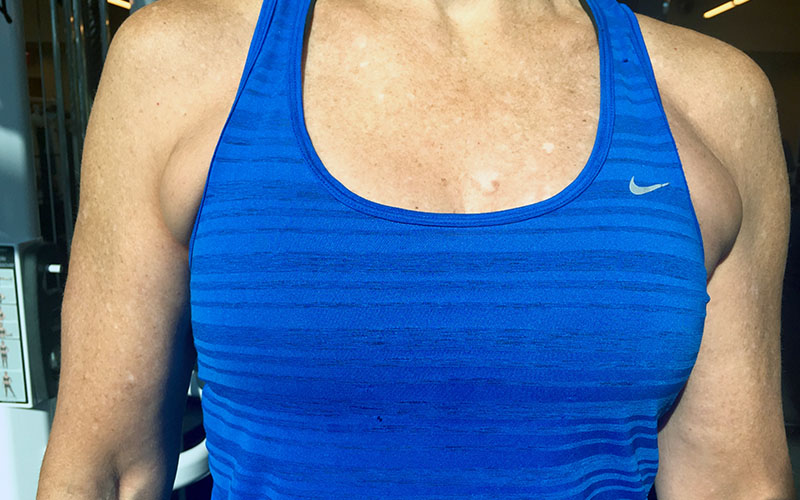
by guest blogger Pam Peeke, MD, MPH, FACP, best-selling author and expert on health, fitness, and nutrition
Recently, I was at the gym working my biceps on the cross-cable. Once done with the set, I relaxed my arms, dropping them to my side. Normally, I walk around and sip water before starting another exercise. This time, I decided to stand there to rest, and as I casually peered into the mirror, I spied something interesting: a small mound of flesh peeking out from each armpit. HAH! I’ve grown two more breasts! Good grief, I have sleevage! Curious, I immediately flexed, and the mounds disappeared. So what’s going on here?

The “sleevage.”
The answer is I’m experiencing normal age-related shape-shifting. We all do, including lifelong athletes like myself. Our body composition does change, especially after the age of 40. Fat is redistributed throughout the body, governed by a number of factors, including:
Declining Sex Hormones
After the age of 30, men’s testosterone begins to decrease by 1 percent per year. That’s just enough to soften the belly with more subcutaneous (“pinch-an-inch”) fat and add a layer of fat over that nice six-pack. Declining testosterone also enables more fat to accumulate deep inside the abdomen, raising the risk of heart disease, diabetes, and cancer. This is most pronounced in men who are sedentary and are overeating relative to their activity level.
As women enter their 40s and the perimenopause stage, when estrogen is gradually beginning to wane, most will notice a shape-shifting from the typical hourglass to, as one of my patients once called it, a “shot glass.” This is because estrogen directs fat deposition onto the hips, thighs, and buttocks, which are the repositories of calories used for breastfeeding. As a woman enters perimenopause, fat now preferentially deposits in a more male-like pattern, around and inside the abdomen, an area I have termed the MENOPOT. Men, yours is the MANOPOT.
In addition, women of all sizes may experience an increase in their bust—some up to an entire cup size larger. Along with that, more fat also appears throughout the upper chest, including the region below the breasts, as well as inside the angle between the armpit and chest. Voilà, there’s the origin of my sleevage! Remember, this occurs as a result of the aging process in just about everyone’s body, regardless of size. However, fitter and healthier folks have less of a problem with any fatty shape-shifting—some only seeing minimal changes.
Decreasing Metabolism
Normally, basal metabolic rate (BMR) accounts for 50 to 70 percent of your total energy expenditure. After the age of 25, studies show that your BMR begins to decline at the rate of 1 to 2 percent per decade. That amounts to about a 150- to 200-calorie decrement in daily eating. By the time you’re 50 to 60 years old, BMR can be 5 percent lower, compared with people half that age. The reasons for the decline include a decrease in highly metabolically active muscle mass (mostly through disuse) as well as an age-related decrease in the metabolic efficiency of existing muscle mass. Fit men and women will note the least change in metabolism throughout their lifespan. That’s because they’re keeping the metabolic machine—their muscles—trained and therefore, optimizing calorie burn.
Genetics
Look at your parents, grandparents, and other older family members for inherited tendencies toward a particular body shape. It doesn’t necessarily mean you’ll definitely inherit their fat distribution as you age, but you may tend toward it. Staying physically active and practicing healthy lifestyle behaviors will always optimize your unique body composition.
As I always say, Genetics may load the gun, but lifestyle choices pull the trigger!
MORE: You Are What Your Grandparents Ate
I decided to share my sleevage pics on my professional Facebook page, posting:
Now, if you’re wondering what to do with the puffs of flesh under the armpits, there’s no such thing as spot reducing. You just do your best to optimize healthy whole food nutrition, watch your portions, as you need less as you age (yeah, you heard me right), and ramp up your strength training, which is incorporated with high-intensity intervals in cardio, as well. That combo will help you achieve a healthy and fit body as you age.
And if some fat pokes out to greet the world, SO WHAT? You’re healthy, you’re HERE, you’re enjoying life, and this is just something that occurs with a healthy aging process, and is unique to each of us. No one is photoshopping away my two pit pals. Which, by the way, are key places actresses and models highlight in photoshopped pics. Nah, I like being real and showing what really happens with the aging process.
My Facebook community ignited with terrific comments, including the following tips and thoughts on how best to manage your own shape-shifting as the years roll by.
Celebrate being here. Cynthia said it best, “At 57, I have new mounds poking out everywhere. My body is truly a wonderland of surprising new fluff. Oh well, nothing but grateful. Eighteen-year breast cancer survivor!” Now, that’s a winning attitude. She’s doing her best and practicing gratitude for a wonderful, functioning mind and body after all she’s been through.
You’re not alone. Lisa said, “Well, at least it’s not just me.” It’s all of us. The key is to keep up an active, healthy lifestyle throughout your life, making the best of the mind and body you have.
Get real about aging. Nora Ephron’s best-selling book I Feel Bad About My Neck and Other Thoughts on Being a Woman is populated with short, witty chapters on all things aging. In one, she imparts wisdom about body changes:
At the age of fifty-five you will get a saggy roll just above your waist even if you are painfully thin. This saggy roll just above your waist will be especially visible from the back and will force you to reevaluate half the clothes in your closet, especially the white shirts.
Clearly, Cassie’s got her own reality check: “Dang! I thought I had purchased the wrong size sports bra and that it was just too tight. I, too, have discovered these new puffs in the same spot. Fitness is my business (Pilates instructor/personal trainer), so it’s even more surprising to see it. I’m super fit, pump a lot of iron, eat lean and clean, and it still happened. I’m 46. I would say that I’ve seen the biggest change in my body this past year. A general sagging of the skin. Gravity. You can still see the muscles, but you can see the skin drooping, too.”
And here’s some great advice from Lisa: “The ‘so what’ attitude is critical for those of us 50+. Changes in fat distribution are normal—even among the fit. I count myself in that group. They way I combat the problem is by ridding myself of clothes that suddenly no longer flatter my figure. Let it go. And then go take a long walk.”
The lesson here is important. Maintain an active and healthy lifestyle, always pushing your own envelope to optimize the aging process. Feel great about your accomplishment and keep it rocking. Know you’ve done your absolute best given your current circumstances and efforts. And if there’s a sag or a puff of fluff here and there, you’re fine! That’s completely normal. The great Senior Olympians have sagging skin overlying strong muscles. It’s never stopped them from winning gold.
MORE: Sweet Weight-Loss Success from Across the Pond
Patiently navigate life’s speed bumps. Once you hit 45 or 50, trust me, just about everyone starts creaking somewhere. Injured body parts may need interventions that temporarily thwart our efforts to stay on track. Risa shares: “I’m so glad to hear you talk about these things. Timing: I’m going through my change of clothes in the closet for the coming fall and yes, there are things that I just CANNOT wear anymore—they won’t zip up just at the bra spot. I weigh exactly what I weighed when I got married in 1984…but between shrinking in height, menopause, and the weight redistributing, it’s just NOT the same body…ugh. Oh, well, 60 isn’t 50, and 50 isn’t 40 and I can keep on going—but I’m still a happy camper…at this age.”
“But I’m still a happy camper at this age…” is a terrific conclusion that all of us need to embrace.
 Pamela Peeke, MD, MPH, FACP, is a Pew Scholar in nutrition and metabolism, an assistant professor of medicine at the University of Maryland, and a fellow of the American College of Physicians. As Senior Science Adviser to Elements Behavioral Health, she’s creating an integrative lifestyle plan to support the treatment of addiction and mood disorders. A Senior Olympic triathlete, she is known as “the doc who walks the talk,” living what she’s learned as an expert in health, fitness, and nutrition. She is also the best-selling author of many books, including Fight Fat after Forty and Body-for-Life for Women. Her newest book is the New York Times bestseller The Hunger Fix.
Pamela Peeke, MD, MPH, FACP, is a Pew Scholar in nutrition and metabolism, an assistant professor of medicine at the University of Maryland, and a fellow of the American College of Physicians. As Senior Science Adviser to Elements Behavioral Health, she’s creating an integrative lifestyle plan to support the treatment of addiction and mood disorders. A Senior Olympic triathlete, she is known as “the doc who walks the talk,” living what she’s learned as an expert in health, fitness, and nutrition. She is also the best-selling author of many books, including Fight Fat after Forty and Body-for-Life for Women. Her newest book is the New York Times bestseller The Hunger Fix.




No comments yet.